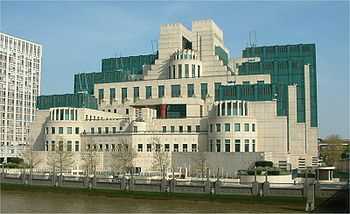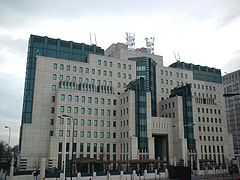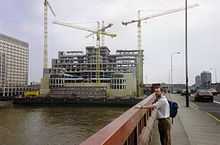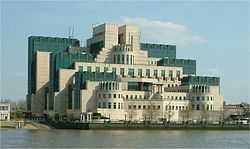SIS Building
| Vauxhall Cross | |
|---|---|
|
A view of SIS's Vauxhall Cross headquarters from Millbank in 2004 | |
| Alternative names |
Legoland,[4] Ceausescu Towers,[5] Babylon-on-Thames,[6] Vauxhall Trollop[7] |
| General information | |
| Architectural style | Postmodern |
| Address | 85 Albert Embankment, Vauxhall, Lambeth |
| Town or city | London |
| Country | United Kingdom |
| Coordinates | Coordinates: 51°29′14″N 0°07′28″W / 51.487263°N 0.124323°W |
| Completed | April 1994 |
| Inaugurated | July 1994 |
| Client | Secret Intelligence Service |
| Owner | HM Government |
| Technical details | |
| Floor area | 252,497 square feet (23,457.7 m2) |
| Design and construction | |
| Architect | Terry Farrell and Partners |
| Main contractor | John Laing plc |
The SIS Building or MI6 Building at Vauxhall Cross houses the headquarters of the British Secret Intelligence Service (SIS, MI6). It is located at 85 Albert Embankment in Vauxhall, a south western part of central London, United Kingdom, on the bank of the River Thames beside Vauxhall Bridge.
Background
MI6 had previously been based at Century House, a 22-storey office block on Westminster Bridge Road, Lambeth, near Waterloo Station.[5] The location of the headquarters was classified information, though the Daily Telegraph reported that it was 'London's worst-kept secret, known only to every taxi driver, tourist guide and KGB agent'.[7] Century House was described as "irredeemably insecure" in a 1985 National Audit Office report with security concerns raised in a survey; the building was made largely of glass, and had a petrol station at its base.[7][8] Security concerns combined with the remaining short leasehold and cost of modernizing the building were important factors in moving to a new headquarters.[7]
Design and construction
The site on which the SIS building stands had been the location of the Vauxhall Pleasure Gardens in the 19th century.[9] Several industrial buildings were subsequently built on the site after the demolition of the pleasure gardens in the 1850s, including a glass factory, a vinegar works and a gin distillery.[9] Archeological excavation of the site during building found the remains of seventeenth century glass kilns, as well as barge houses and an inn called The Vine. Evidence was also found for a river wall on the site.[9]
In 1983 the site was bought by property developers Regalian Properties.[9] A competition to develop the site was won by architect Terry Farrell, with an urban village as Farrell's original proposal.[9] A scheme of office blocks was subsequently developed for the site, with a government agency as their occupier. The building had been sold for £130 million in 1989, with construction planned to take three years, built by John Laing.[9] SIS ultimately became the occupiers of the building.[9] Farrell's design for the SIS building was influenced by 1930s industrial modernist architecture such as Bankside and Battersea Power Stations and Mayan and Aztec religious temples.[9]
-

The SIS building seen from Vauxhall Bridge
-

The opposite side of the building, seen from Vauxhall Cross

Regalian approached the government in 1987 to assess their interest in the proposed building. At the same time, MI6's sister service MI5 was seeking alternative accommodation and collocation of the two organisations was considered. This proposal was ultimately abandoned due to the lack of buildings of adequate size (existing or proposed) and the security considerations of providing a single target for attacks. In July 1988 Prime Minister Margaret Thatcher approved the purchase of the new building for the SIS. The government proposed to pay for the building outright to maintain secrecy over the intended use of the site—at this time the existence of MI6 was not officially acknowledged. The NAO put the final cost at £135.05m for site purchase and the basic building or £152.6m including the service's special requirements.
The numerous layers over which the building is laid out create 60 separate roof areas.[9] 25 different types of glass were used in the building, with 12,000 m2 of glass and aluminum used in the building's construction.[9] The windows in the SIS building are triple glazed for security purposes. Due to the sensitive nature of MI6's work, large parts of the building are below street level, with numerous underground corridors serving the building.[10] Amenities for staff include a sports hall, gymnasium, aerobics studio, and a squash court.[11] The building also features two moats for protection.[12]
The building was completed in April 1994 and officially opened by Queen Elizabeth II accompanied by Prince Phillip, Duke of Edinburgh, in July of that year.[13]
The building was positively critiqued by Deyan Sudjic in The Guardian in 1992 who described it as an 'epitaph for the 'architecture of the eighties'.[14] Sudjic wrote that 'It's a design which combines high seriousness in its classical composition with a possible unwitting sense of humour. The building could be interpreted equally plausibly as a Mayan temple or a piece of clanking art deco machinery', and added that the most impressive thing about Farrell's design was the way he had not 'confined himself to a single idea' as the building 'grows and develops as you move around it'.[14]
Recent history
In September 2000 the building was attacked by unapprehended forces using a Russian-built RPG-22 anti-tank missile, causing superficial damage.[15] The Metropolitan Police recovered the discarded missile launcher at Spring Gardens park in Vauxhall, as well as finding remains of the missile which had exploded against an eighth floor window.[16] Dissident Irish Republicans were believed to have been behind the attack.[17] Writing in The Telegraph after the attack, Alan Judd referred to detractors who wished a less visible physical presence for SIS; writing that "Both sides of the Whitehall debate might now claim vindication by the rocket attack: on the one hand, the building's profile made it an obvious target; on the other, a headquarters with expensive security protection has been shown to be necessary."[7]
In August 2010 two men from North Wales were arrested after a parcel bomb was found at the SIS building's postal handling centre.[18]
The Queen visited Vauxhall Cross for a second time in February 2006,[19] and Charles, Prince of Wales visited in July 2008.[20] In June 2013 Prince Harry visited Vauxhall Cross and was given a briefing on intelligence by staff.[21] During the Thames Diamond Jubilee Pageant, part of the celebrations for the Diamond Jubilee of Elizabeth II in 2012, the London Philharmonic Orchestra played the James Bond Theme as they passed the building. The Daily Telegraph wrote that 'Even MI6 managed to join the party – just. Its headquarters at Vauxhall sported a few discreet rows of bunting. But its balconies remained empty.'[22][23]
The building was lit with pink lights to raise awareness of breast cancer in 2013.[24]
In January 2013 the building was briefly put into a state of alert after the Vauxhall helicopter crash.[25]
Vauxhall Cross has featured in several recent James Bond films. The building was depicted as having been attacked in the Bond films The World Is Not Enough (1999), and Skyfall (2012).[26][27] For The World Is Not Enough a 50 ft high model of the building was constructed at Pinewood Studios.[9] A special premiere of The World Is Not Enough was held at Vauxhall Cross for MI6 staff, who cheered when their headquarters was destroyed in the film.[28]
See also
- Thames House — The headquarters of MI5, the British domestic intelligence agency
- The Doughnut — The headquarters of the Government Communications Headquarters (GCHQ), the British signals intelligence and cybersecurity agency
References
- ↑ "MI6 attack weapon identified". BBC News Online. 22 September 2000. Retrieved 12 March 2015.
Police are continuing extensive searches of the area around the MI6 building
- ↑ "'Rocket' theory over MI6 blast". BBC News Online. 21 September 2000. Retrieved 12 March 2015.
Police are searching all areas around the MI6 building
- ↑ Watson-Smyth, Kate (21 September 2000). "MI6 Building is Rocked by Two Explosions". Independent. Retrieved 12 March 2015.
Two explosions rocked the MI6 building in Vauxhall Cross, central London, last night.
- ↑ "Spooks on Stella". The Guardian. 10 June 2004. Retrieved 17 June 2008.
- ↑ 5.0 5.1 Philip Johnston (22 September 2000). "The very public face of the secret service". The Daily Telegraph. Retrieved 9 November 2014.
- ↑ Carla Power (22 September 2000). "Mission: Possible". Newsweek. Retrieved 11 November 2014.
- ↑ 7.0 7.1 7.2 7.3 7.4 Alan Judd (24 September 2000). "One in the eye for the Vauxhall Trollop". The Daily Telegraph. Retrieved 9 November 2014.
- ↑ Corera 2012, p. 321.
- ↑ 9.0 9.1 9.2 9.3 9.4 9.5 9.6 9.7 9.8 9.9 9.10 "Buildings - SIS (MI6)". SIS. Retrieved 26 December 2013.
- ↑ Mark Henderson. "Heavy security at £75m building." The Times, London, 21 September 2000
- ↑ Francis Wheen. "MI6's big secret: they're useless.", The Guardian, 3 September, pg. 1
- ↑ "MI6 building 'like a fortress'". CNN. 21 September 2000. Retrieved 17 June 2008.
- ↑ "Queen visits Mi6.", The Times, London, 15 July 1994, pg 2
- ↑ 14.0 14.1 Deyan Sudjic. "The building of a not so secret service.", The Guardian, 19 June 1992, pg. 36
- ↑ "'Rocket' theory over MI6 blast". BBC News Online. 21 September 2000. Retrieved 26 December 2013.
- ↑ "Missile launcher in MI6 attack was new to UK". The Independent. 21 September 2000. Retrieved 26 December 2013.
- ↑ "MI6 missile attack: Irish dissidents suspected". The Guardian. 21 September 2000. Retrieved 26 December 2013.
- ↑ James Meikle (1 August 2010). "Two men held over MI6 and Downing Street parcel bombs". The Guardian. Retrieved 26 December 2013.
- ↑ "Court Circular", The Times, London, 11 February 2006, pg. 78
- ↑ "Court Circular", The Times, London, 9 July 2008, pg. 55.
- ↑ Alice Philipson (7 June 2012). "Prince Harry given briefing by MI6 secret agents". The Daily Telegraph. Retrieved 9 November 2014.
- ↑ Neil Tweedie (4 June 2012). "The Queen's Diamond Jubilee: Flotilla sails into history books on a river of goodwill". The Daily Telegraph. Retrieved 9 November 2014.
- ↑ Gordon Rayner (3 June 2012). "The Queen's Diamond Jubilee: Happy and glorious, the river Queen". The Daily Telegraph. Retrieved 9 November 2014.
- ↑ "Iconic landmarks turn pink for breast cancer campaign". The Daily Telegraph. Retrieved 9 November 2014.
- ↑ Gordon Rayner, Duncan Gardham, Andrew Hough (16 January 2013). "Helicopter crash: 'miracle' of how so few died when fire rained down on the rush hour". The Daily Telegraph. Retrieved 9 November 2014.
- ↑ Philip French (28 November 1999). "James'll fix it... as usual". The Guardian. Retrieved 26 December 2013.
- ↑ Philip French (28 October 2012). "Skyfall – review". The Guardian. Retrieved 26 December 2013.
- ↑ Corera 2012, p. 322.
- Corera, Gordon (2012). MI6: Life and Death in the British Secret Service. London: Phoenix. ISBN 978-0-753828-335.
External links
| Wikimedia Commons has media related to Secret Intelligence Service Building. |
